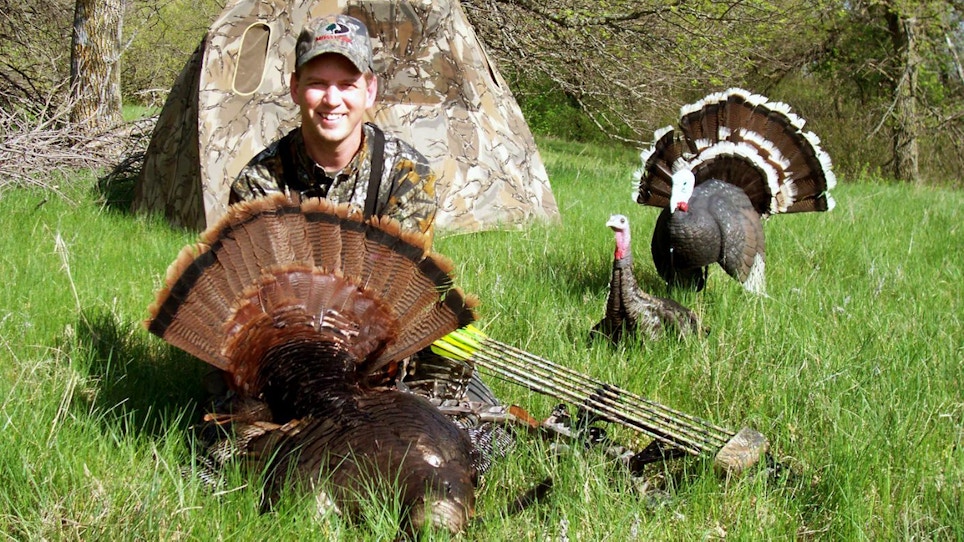
The author arrowed this South Dakota turkey at a range of 10 feet (not yards). To hit the turkey’s vitals precisely, he used his 30-yard bowsight pin.
Regardless of your preference in bowsight style, before heading into the field this spring in pursuit of gobblers you should shoot your turkey-specific arrow/broadhead combo at point-blank range and examine the results.
Of course, if your turkey arrow/broadhead combo is the same as what you used last fall for big game, then arrow trajectory shouldn’t have changed. That said, many turkey hunters incorrectly assume they should use their top pin (fixed-pin bowsight) for point-blank shots, meaning 2-10 yards.
Shots at 5 yards and closer aren’t common on whitetails, but if you bowhunt turkeys from a pop-up ground blind and place your turkeys close — as you should — then chances are good that your shot at a gobbler could be 12 feet instead of 12 yards.
Believe it or not, you’ll likely need to use a bowsight pin that was originally (big game season) meant for 30 or 40 yards to hit a nickel-size bull’s-eye on a target from 3 or 4 yards. Why?
When your arrow flies to strike a target at 30 yards, it crosses your line of sight twice, once early on its path, then at the moment it strikes the target. Think of it this way: The arrow starts low on your bow, upon release it rises above your line of sight as it flies downrange, it reaches its apex on its way to the target, then drops into the bull’s-eye when it hits your line of sight a second time. It flies in an arc.
Note that I wrote “early on its path” and didn’t mention a specific distance because it will vary depending on your bow/arrow/bowsight/rest setup. On my rig, my 30-yard bowsight pin is dead-on at 30 yards AND 4 yards. This means if I have a turkey at 4 yards, and I want to put my arrow in a turkey’s cheek (head/neck-type broadhead), then I need to use my 30-yard bowsight pin.

The only way to know which pin to use for point-blank shots on turkeys is to test it with the arrow/broadhead you’ll use this spring. The good news is assuming you own a portable target, you can test this in your basement, or even your living room (be safe, of course).
Let’s assume you have a fixed-pin bowsight with pins set for 20, 30 and 40 yards. Many beginning turkey hunters when faced with a 4-yard shot make the mistake of thinking: I’ll use my 20-yard pin, but aim a couple inches low because the range is much less than 20.
This is wrong. Test it at home or at the range and see for yourself. Chances are good that even if you aimed dead-on with your 20-yard pin at 4 yards, your arrow will strike a couple inches low. And if you compensate the wrong way (by aiming lower with your 20-yard pin), your arrow will hit lower by even more.
When you determine the correct pin for point-blank shots, you’ll have the confidence to hit your target, even when that target is gobbling its head off less than 5 yards away.






